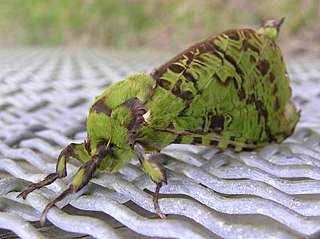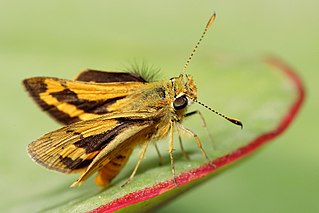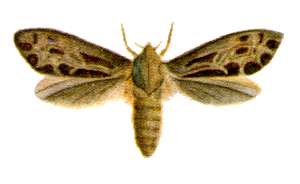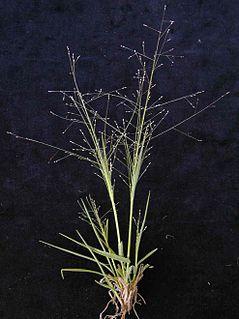
The Hepialidae are a family of insects in the lepidopteran order. Moths of this family are often referred to as swift moths or ghost moths.

Aenetus is a genus of moths of the family Hepialidae. There are 24 described species found in Indonesia, New Guinea, New Caledonia, Australia and New Zealand. Most species have green or blue forewings and reddish hindwings, but some are predominantly brown or white. The larvae feed in the trunks of living trees, burrowing horizontally into the trunk, then vertically down.

Johnson grass or Johnsongrass, Sorghum halepense, is a plant in the grass family, Poaceae, native to Asia and northern Africa. The plant has been introduced to all continents except Antarctica, and most larger islands and archipelagos. It reproduces by rhizomes and seeds.

The red-chested buttonquail is a species of bird in the family Turnicidae. It is endemic to Australia. The species is generally regarded as widespread, although uncommon, in New South Wales, Queensland, northern Western Australia and the Northern Territory, and classified as Vulnerable in Victoria.

Panicum decompositum, known by the common names native millet, native panic, Australian millet, papa grass, and umbrella grass, is a species of perennial grass native to the inland of Australia. It occurs in every mainland state. The seeds can be cultivated to produce flour typically used in Aboriginal bushfood. The species is also considered to have relatively high palatability by livestock, making it suitable for grazing pastures.

Ocybadistes walkeri, the greenish grass-dart, green grass-dart, southern dart or yellow-banded dart, is a type of butterfly known as a skipper found in eastern and southern Australia, with one subspecies found in the Northern Territory.

Caesia is a genus of herbs in the family Asphodelaceae, subfamily Hemerocallidoideae, native to Australia, New Guinea, Madagascar and Southern Africa. The mostly 3-lobed seed capsules contain rounded black seeds. The genus was named in honour of Federico Cesi (1585-1630), an Italian scientist.
- Caesia alpina Hook.f. - alpine grass-lily - New South Wales, Tasmania, Victoria
- Caesia calliantha R.J.F.Hend. - blue grass-lily - New South Wales, Tasmania, Victoria, South Australia
- Caesia capensis(Bolus) Oberm. - Cape Province of South Africa
- Caesia chlorantha F.Muell. - New South Wales, Queensland, Western Australia
- Caesia micrantha Lindl. - New South Wales, Tasmania, Victoria, South Australia, Western Australia, Queensland
- Caesia occidentalis R.Br. - Western Australia
- Caesia parviflora R.Br. - pale grass-lily - Queensland, New South Wales, Tasmania, Victoria, South Australia, Western Australia
- †Caesia rigidifolia F.Muell. - Queen Victoria Springs in Western Australia but extinct. Last recorded near Zanthus in 1875.
- Caesia sabulosaBoatwr. & J.C.Manning - Cape Province
- Caesia setifera Baker - Queensland, Western Australia, Northern Territory, New Guinea
- Caesia subulataBaker - Madagascar
- Caesia viscida Keighery - Western Australia

The Tasmanian grassgrub or corbie is a moth of the family Hepialidae. It is found in Tasmania.

Neurachne, commonly called mulga grass, is a genus of Australian plants in the grass family.

Hesperilla donnysa, the donnysa skipper or varied sedge skipper, is a butterfly of the family Hesperiidae. It is found in the Australian Capital Territory, New South Wales, Queensland, South Australia, Tasmania, Victoria and Western Australia.

Panicum effusum, commonly known as hairy panic, is a grass native to inland Australia. It occurs in every mainland state, as well as New Guinea. In dry conditions, the fast-growing grass can become a tumbleweed.

Herpetogramma licarsisalis, the grass webworm or tropical grass webworm, is a moth of the family Crambidae. It is native to most of the old world tropics, including New Zealand, Hong Kong and Queensland. It is an introduced species in many other parts of the world, including Hawaii and the Canary Islands.

Fraus simulans, the lesser ghost moth, is a moth of the family Hepialidae. It is endemic to the Australian Capital Territory, New South Wales, Queensland, South Australia, Tasmania, Victoria and Western Australia.
Oncopera alboguttata is a moth of the family Hepialidae. It is found in New South Wales and Queensland.
Oncopera brachyphylla is a moth of the family Hepialidae. It is found in Queensland, Australia.
Oncopera fasciculatus, the underground grassgrub, is a moth of the family Hepialidae endemic to South Australia and Victoria. The fore wings are brown with a pattern of dark splotches. The hind wings are plain brown. The larvae live in vertical tunnels in the soil. They emerge at night to feed on the leaves of grasses in native and sown pastures.
Oncopera mitocera is a moth of the family Hepialidae. It is found in Queensland, Australia.
Oncopera tindalei is a moth of the family Hepialidae. It is found in New South Wales, Australia. It was named after Australian entomologist Norman Tindale.

Leptochloa chinensis, commonly known as red sprangletop, Asian sprangletop, or Chinese sprangletop, is a grass species. It is a serious weed of rice.

Panicum hillmanii, commonly known as Hillmann's panicgrass, is a grass from genus Panicum native to Southwestern United States. It has been introduced to many other areas, notably including southern Australia where it became widespread, and several parts of Europe.















